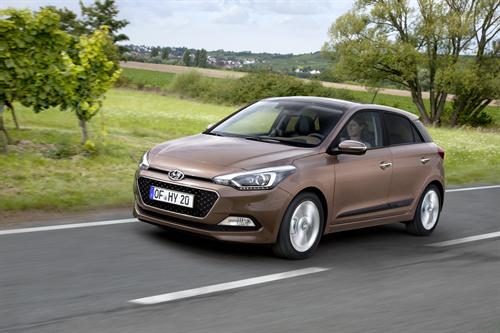
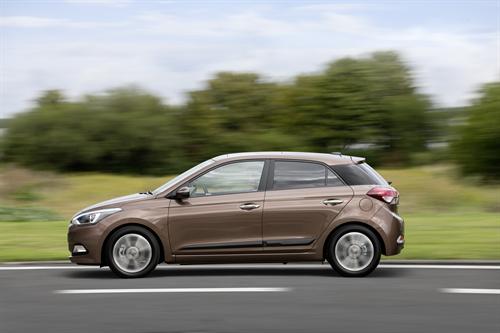
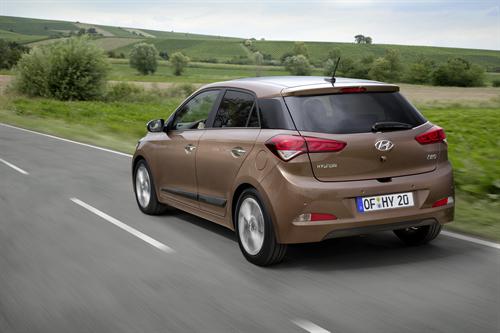

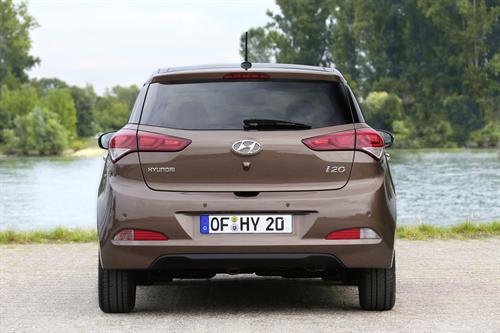
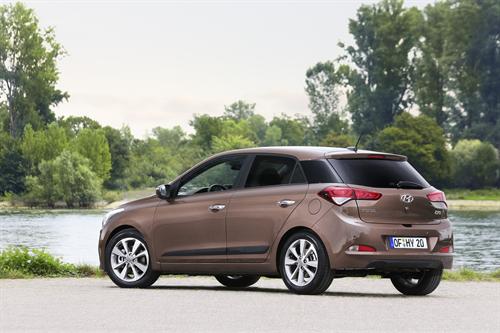
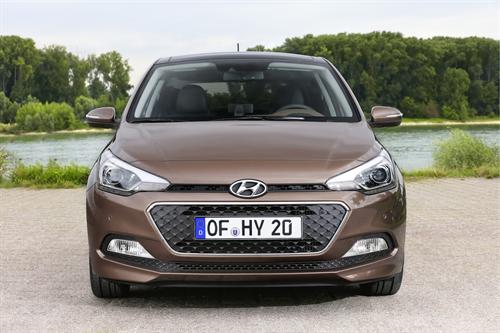
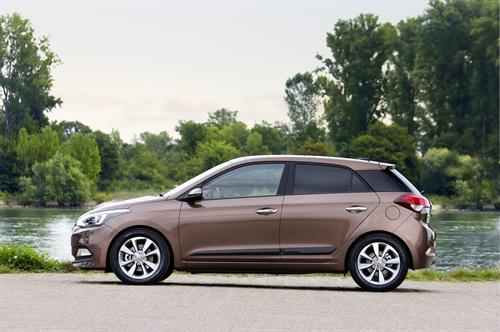 Three-door model to join New Generation i20 family
Three-door model to join New Generation i20 family- Sketch reveals clear differentiation in design
- Designed, engineered and built in Europe alongside five-door model
High Wycombe, 3 September – Hyundai Motor has revealed a first impression of the New Generation i20 Coupe, indicating how the company’s model range will grow beyond the recently revealed five-door version.
The new model promises to combine driving fun, a distinctive character and sporty refinement, with the enhanced practicality and quality already previewed in its five-door sibling.
The New Generation i20 Coupe features a more sharply raked roofline and a distinctive roof spoiler, enhancing its sporty exterior. In keeping with the New Generation i20 family, the Coupe’s long hood and generous proportions create a powerful stance, while the overall architecture maintains a clear and simple design. Meanwhile, at the back, the wrap-around rear window and unique treatment for the lamp clusters communicate the model’s sophisticated design.
Like the five-door version, New Generation i20 Coupe was designed and developed at Hyundai Motor’s Design Centre Europe in Rüsselsheim, Germany.
Further details about New Generation i20 Coupe will be announced in due course.
Hyundai New Generation i20 – Contents
01 Introduction
New Generation i20 – space and substance meet style and refinement
02 Styling and design
Sophisticated design inside and out
03 Comfort and convenience
Class-leading space and segment-first technologies
04 Engines and transmissions
Four proven and tested engines available
05 Running gear
European-tuned chassis offers comfort-orientated ride
06 Safety
Premium-segment safety features as standard
07 Production
Unification of production at company’s European factory
08 The marketplace
Hyundai aims to capture more of the growing B-segment in Europe
09 Technical specifications
Technical details of the New Generation i20
1. INTRODUCTION
New Generation i20 – space and substance meet style and refinement
At a glance
- Sophisticated design: elegant lines and refined details
- Class-leading interior space makes New Generation i20 a true five-seater
- High specification and unique-in-segment features
- Engineered to deliver pleasurable ride on European roads
- Designed, engineered and made in Europe following recent investment
- Third car launched under Product Momentum 2017 initiative
With the launch of its latest model, the New Generation i20, Hyundai Motor Europe is continuing its successful presence in the B-segment, highlighted by almost a million sales since 2002. The popularity of the original i20 has made it one of the company’s best-selling cars in the region. The key aims of the new model are to open Hyundai Motor Europe to an even wider audience, further develop perceptions of the brand and confirm Hyundai’s strategic focus on Europe.
The New Generation i20 has been designed and developed in Europe, and three key attributes in particular underline how it meets the needs of European consumers: class-leading interior space, high-technology and comfort-enhancing features, and clean, refined design.
Hyundai’s third-generation B-segment vehicle highlights a significant step forward for the company since 2002, when Getz was first introduced to Europe. The New Generation i20 remains true to the principles of delivering value beyond expectations, exemplified by models including New Generation i10 and New ix35. The launch of this latest vehicle also means every Hyundai model in Europe has been renewed in the last five years.
Making its debut at the 2014 Paris Motor Show in October and entering production during the same month, the New Generation i20 will go on sale throughout Europe from November 2014.
Longer, lower and wider than the previous model, New Generation i20 was penned at Hyundai Motor’s Design Centre Europe in Rüsselsheim, Germany. The new model’s character is inspired by the company’s Fluidic Sculpture design philosophy, with elegant lines and a sculptured profile giving it a bold and sophisticated appearance. On the New Generation i20, a Hyundai Motor’s key design element hexagonal grille flows into stylish bi-function headlamps with LED daytime running lights.
Key styling cues are echoed inside the spacious cabin. Sitting on a new platform, the wheelbase has been extended by 45 millimetres to 2570 mm creating more space for occupants. Class-leading interior space – 1892 mm combined front and rear legroom – makes the New Generation i20 a true five-seater, while outstanding boot capacity of 326 litres heightens the vehicle’s versatility.
Designed to transport the driver and passengers in great comfort, the cabin features extensive use of soft-touch materials, as well as subtle piano black inserts and chrome detailing, to create a modern and sophisticated interior package.
The vehicle has also been fitted with a number of new technologies that provide levels of comfort and convenience normally associated with large-vehicle segments. For example, the inclusion of front and rear parking assist, heated steering wheel, static bending headlamps and automatic defog system are firsts for a Hyundai B-segment vehicle. Additionally, the lane departure warning system is another innovative feature, normally found in higher segments. The unique-in-class panoramic sunroof, able to both tilt and fully open, enhances the comfort and the sense of space for occupants, filling the cabin with natural light and fresh air.
The New Generation i20’s driving experience has been fine-tuned to ensure suitability for European roads following rigorous ride and handling testing in alpine mountain areas, hot summer evaluation in southern Europe and cold winter testing in Scandinavia. During testing, New Generation i20 was tested at altitudes as high as 2500 metres and subjected to temperatures ranging from +40 Celcius down to -35 Celcius. The extensive use of lightweight high-strength steel in the platform and bodyshell has yielded a reduction in core weight of the vehicle, as well as a significant improvement in torsional rigidity, reducing vibrations when on the move and aiding handling performance.
Hyundai Motor’s confidence in its European build quality means every New Generation i20 comes with the company’s industry-leading Five Year Unlimited Mileage Warranty, as standard. This industry-best support package also includes five years of roadside assistance and five years of vehicle health checks.
As a further demonstration of Hyundai’s commitment to Europe, and underlining the fact that the car is a truly European vehicle, Hyundai has unified New Generation i20 production at its Turkish plant. 100% of New Generation i20 production will take place at the recently-expanded Hyundai Assan Otomotiv Sanayi (HAOS) plant in Izmit, Turkey.
The New Generation i20 is the third car to be launched as part of ‘Product Momentum 2017’, an initiative that will see Hyundai launch 22 new models and derivatives in Europe by 2017. New products and new technologies will further Hyundai’s regionalisation strategy of designing, engineering and producing cars for Europe, in Europe.
2. STYLING & DESIGN
Sophisticated design inside and out
At a glance
- Latest interpretation of Hyundai Motor’s design philosophy
- Class-leading roominess – when space meets style
- Design penned at Hyundai Motor’s Design Centre Europe
- Longer, lower and wider bodyshell, with extended wheelbase
- Widest range of available interior colours in the B-segment
The original i20 was one of Hyundai Motor’s first truly European vehicles, designed, developed and built in the region. It later featured a progressive design and hexagonal grille that became a hallmark of Hyundai design.
The design of New Generation i20 was led at Hyundai Motor’s Design Centre Europe in Rüsselsheim, Germany.
The distinctive design was influenced by the latest interpretation of Hyundai Motor’s design philosophy, Fluidic Sculpture 2.0, with the clean and elegant lines giving it a sophisticated appearance.
With a larger platform than its predecessor, the wheelbase of the New Generation i20 is 45 mm longer (now 2570 mm) than the outgoing model, meaning the wheels are closer to each corner. The European design team paid particular attention to achieving balanced proportions, with the generous shape and long hood creating a powerful stance.
Compared to its predecessor, the New Generation i20 is longer, wider and lower. The bodyshell is 40 mm longer (overall length 4035 mm) and 16 mm lower (overall height 1474 mm). The width has increased by 24 mm (overall 1734 mm) making it one of the widest cars in its class. The overhangs at the front of the vehicle have been shortened to communicate the dynamic qualities of the driver experience.
Exterior dimensions (mm)
| New Generation i20 | + / – | Original i20 | |
| Length | 4035 | +40 | 3995 |
| Width | 1734 | +24 | 1710 |
| Height | 1474 | -16 | 1490 |
| Wheelbase | 2570 | +45 | 2525 |
| Overhang (front) | 815 | – | 815 |
| Overhang (rear) | 650 | -5 | 655 |
The bodyshell incorporates a single feature line running the length of the vehicle just below the windows and connecting at the rear. A waistline moulding at the base of the door – first exhibited on the New Generation i10 –creates a sleek profile, which is complemented by the soft, sculptured ‘undercuts’ of the body panels.
The European team has created a bold front aesthetic that now features a distinctive dual-element grille. The upright chrome-framed hexagonal grille has been lowered for design and engineering purposes, while a thin, horizontal grille connecting the bi-function headlamps (incorporating daytime running lights), emphasises the width of the vehicle. Reinforcing the vehicle’s purposeful stance, the wheel arches subtly flow into the long hood.
On New Generation i20, the A-pillars are thinner, shorter and more upright, achieved via the use of advanced high-strength steel. The redesigned pillar creates more interior space for occupants as well as enhancing the driver’s field of vision, making exiting junctions safer and manoeuvring in tight city spaces easier.
At the rear, the New Generation i20 features a wrap-around, gloss-finished black
C-pillar that gives the impression of a floating roofline. The feature line that runs the length of the vehicle connects at the rear – dropping subtly below the rear window to improve visibility.
The lamp clusters wrap around the rear wing into the trunk lid and feature a distinctive ‘boomerang’ LED design.
Thomas Bürkle, Chief Designer at Hyundai Motor’s Design Centre Europe, commented: “The bold and distinctive volume of the new i20 gives the car a unique personality, which is underlined by the premium look of the headlamps and rear combi lamps. For example, the concave element below the rear lamp expresses the 3 dimensional and sculptural aspect of the Hyundai design language.”
The purposeful appearance of New Generation i20 is emphasised by its long hood, low roofline and sharp crease line that combine to achieve a more streamlined vehicle, lowering the car’s aerodynamic drag figure to 0,30 Cd (from 0,32 Cd for the previous i20).
At the rear, New Generation i20 features a large tailgate for ease of loading into its generous boot space (up 10% on the previous generation car to 326 litres). The 1027 mm wide opening is one of the broadest in the segment. A prominent Hyundai badge sits above an optional integrated rear-view camera, a feature usually associated with vehicles from sectors above.
The reversing lamp has been integrated into the rear bumper – a first for Hyundai. The decision to re-position the lamp was based purely on design factors, allowing greater styling flexibility within the rear LED lamp cluster.
The broad appeal of the New Generation i20 to new and existing customers will be further enhanced by the widest range of interior and exterior colour combinations available on a B-segment car. The new model will be available in nine vibrant exterior shades, comprising two solid (Baby Elephant and Polar White), four metallic (Mandarine Orange, Iced Coffee, Sleek Silver and Star Dust) and three pearl (Aqua Sparkling, Phantom Black and Red Passion).
Inside, the New Generation i20 offers the widest choice of interior colours on the market. The upholstery is available in two materials – cloth and leather – and the dashboard and seats are colour-coordinated. The cloth seats can be specified in four colours: Comfort Grey, Elegant Beige, Cappuccino and Blue Grey, while the leather seats are black, featuring distinctive colour stitching.
All of New Generation i20’s key surfaces are colour coded to provide a connected and premium feel for the interior space. Each interior colour took inspiration from everyday items, giving each its own distinctive character. The colours have been designed to create an elegant and calm interior environment, with the colour blocks throughout the cabin visible from the outside and complementing the exterior colour.
A coloured inlay that runs the full width of the dashboard and around the handle on the door emphasises the width and available space, giving the cabin a brighter feel. Slimmer and wider than the inlay in New Generation i10, it encompasses the redesigned air vents, which overhang the dashboard into the doors that have been shaped specifically to provide better air flow into and around the cabin. The inlay matches the colour of the seat and door armrest upholstery.
The refined stitching of the seat padding was developed and executed to the highest standards to be functional and stylish, in keeping with the rest of the interior design.
Hyundai Motor’s ergonomics team worked to produce ‘functional clustering’ of the key technologies, grouping together instrumentation such as the audio, heating and ventilation, and powered window systems, to yield a cleaner cabin visual.
3. COMFORT AND CONVENIENCE
Class-leading space and segment-first technologies
At a glance
- High-grade materials and design enhance levels of perceived quality
- Class-leading levels of interior space thanks to longer wheelbase
- Outstanding boot capacity: 326 litres (up 10%)
- Hyundai Motor introduces several new technologies to the B-segment
- Equipment and trim levels usually found in C-segment cars and higher
- New NVH features create one of the quietest cabins in the class
With a large cabin and a generous list of standard technologies, including some ‘firsts’ for the European B-segment, the New Generation i20 offers a sophisticated and luxurious occupant environment that will appeal to a young audience.
The new, larger platform on which the New Generation i20 is based has a wheelbase that is 45 mm longer (now 2570 mm), providing greater interior space to match the sophisticated look.
Thanks to its increased dimensions and ergonomic cabin packaging, the New Generation i20 is one of the most competitive cars in its class for interior spaciousness. The new model is longer, wider and lower, providing Hyundai Motor’s designers with more space to create a genuine five-seater for the B-segment, with the new model now yielding a more substantial cabin space.
The New Generation i20 offers combined front and rear legroom of 1892 mm, a class-leading figure and comparable with the space of a C-segment vehicle. Despite its lower roofline, the more substantial footprint and lower seat position enhance interior dimensions, allowing five adults to travel in comfort.
Compared with the previous model, front-seat occupants enjoy 33 mm greater headroom (1038 mm), more legroom (+24 mm to 1098 mm), a 6 mm increase in the hip room (1301 mm) and 15 mm more shoulder space (1365 mm). In the rear of the cabin, headroom of 978 mm, legroom of 794 mm and shoulder room of 1350 mm allow three adults to be seated in comfort.
Additional legroom was created in the front by raising the height of the dashboard and moving the glovebox and surrounding components forward – made possible due to the longer hood.
Cargo capacity has also been enhanced, making the vehicle one of the most accommodating in the segment. The boot volume has increased by 10% to a class-leading 326 litres (previously 295 litres) with the rear seats upright.
Thanks to clever packaging, the rear bench can fold fully flat, meaning trunk capacity is boosted to 1042 litres with the rear seats folded – ideal for young families and those carrying larger items. A two-stage luggage floor board can be moved up or down to conceal items and create additional storage options.
To emphasise the generous interior proportions and create an open and airy cabin, the New Generation i20 features a full-length panoramic sunroof that floods the cabin with natural light. The panoramic sunroof can both tilt and fully open – unique for the B-segment – allowing occupants to tailor the amount of fresh air entering the cabin, while a sun shade protects occupants from direct sunlight.
Front-seat occupants benefit from larger cup holders in the centre console and a 1.5-litre bottle storage in the doors as well as a centre console box, greatly enhancing secure storage space. Rear doors feature a 1.0-litre bottle storage space. The lid of the centre console box is finished with a soft-touch fabric, allowing it to double as an arm rest. The driver and front-seat passenger can also make use of a roof-mounted sunglasses holder.
One of the key goals for the design team was to ensure the New Generation i20’s perceived interior quality was among the very best in the segment. The cabin has undergone extensive ergonomic testing to ensure it is easy and pleasant to use, while retaining a sense of premium quality. The dashboard is asymmetric, angled five degrees towards the driver to make it as practical and user-friendly as possible, though it appears symmetrical to occupants.
Hyundai Motor’s engineers and designers have selected a number of high-quality, high-durability materials to ensure the cabin provides lasting comfort and good looks.
On many of the cabin’s key surfaces a high-grade Thermal Plastic Olefin (TPO) material has been applied, including on the vehicle’s dashboard and door trims. The soft-to-the-touch material is highly durable, maintaining a premium look and feel even after frequent use.
“The dash and the door materials are the first a potential customer touches after the steering wheel, so these need to be good quality and, most importantly, soft,” commented Christian Löer, Head of Product Management and Pricing at Hyundai Motor Europe.
Hyundai Motor has, for the first time equipped the cabin with subtle piano black inserts, in addition to chrome detailing around the air vents and gear shift lever to create a modern and sophisticated interior package. The piano black and chrome finishes continue around the start/stop button, audio and HVAC unit controls.
The new platform and generous shape of the New Generation i20 have been developed using more lightweight, high-strength steel to yield stiffer torsional rigidity. The result is an improvement in ride quality, reduction in core weight and gains in damping to mitigate noise, vibration and harshness (NVH).
The body structure is composed of 42% lightweight, ultra high-strength steel, compared with 16% in the outgoing model. Together with reinforcing loops fitted to the B- and C-pillars and the tailgate opening, this raises torsional rigidity by 81% (to 23.2 kgf m2/rad).
Throughout the new model, Hyundai engineers have applied technologies aimed at reducing the intrusion of noise and vibration to the cabin. Increased sound-absorption at the base of the A-, B- and C-pillars protects occupants from road vibrations, while a high-density anti-noise pad is fitted within the floor pan to limit noise ingress. Hyundai has equipped New Generation i20 with an improved, low-frequency ISO PAD behind the dashboard, which helps reduce engine noise within the cabin.
In the pursuit of a quieter interior, the New Generation i20’s external mirrors have been designed to improve airflow. Additionally, by fitting an inner belt to the door frame, Hyundai engineers have ensured a tighter close between it and the B-pillar, removing possible air interruption and, therefore, wind noise.
The New Generation i20 embodies the company’s approach to delivering value beyond expectations, with the brand democratising a number of new technologies straight from the D- to the B-segment. In the same way that All-New Genesis offers buyers a number of segment innovations, so New Generation i20 is fitted with technology that has never been seen before in a B-segment car, for example, the Lane Departure Warning System (LDWS).
To further help the New Generation i20 stand out from the competition, the car features two unique comfort-orientated technologies, which were first fitted to the Hyundai i40: automatic windscreen defog and a heated steering wheel.
Other new features include a dashboard-integrated seven-inch satellite navigation system (the first time Hyundai Motor has applied this technology in its B-segment car), automatic folding door mirrors, front and rear parking assist, and smartphone docking integration. USB and auxiliary connectivity is fitted as standard and can be specified with an integrated My Music function along with Bluetooth hands free, where up to 1GB of music can be stored and played.
The New Generation i20 features enhanced instrumentation thanks to a 3.5-inch OLED LCD Supervision Cluster to provide a wide range of information to the driver in high-resolution clarity.
By unifying production of New Generation i20 in Turkey, Hyundai has been able to focus on developing a specification exclusive to European consumers. The car is available in four highly-equipped trim levels, all aimed at delivering true value: ‘Access’, ‘Comfort’, ‘Panorama’ and ‘LED’.
4. ENGINES AND TRANSMISSIONS
Four proven and tested engines available
At a glance
- Engine line-up tuned to optimise day-to-day driveability
- European powerplants provide more maximum and low-end torque
- Choice of 1.25- and 1.4-litre petrol, 1.1 and 1.4-litre diesel engines
- Five- and six-speed manual and four-speed automatic transmissions
- All engines are Euro 6 compliant
The New Generation i20 is available with a choice of two Hyundai ‘Kappa’ gasoline and two ‘U-II’ diesel power units. These proven powerplants have been carried over from the previous-generation model with a number of improvements to enhance driveability and ensure compliance with new Euro6 emission regulations.
Hyundai’s European engineering team, based at the Technical Centre in Rüsselsheim, Germany, focused on developing powertrains to better suit the demands of the region’s buyers. Hyundai engineers tuned each unit to deliver more maximum and low-end (2000 rpm) torque, enabling a more accessible and responsive driving experience day-to-day. As a result, for example, the New Generation i20 can accelerate between 80 and 120 kph faster than before.
Gasoline
Buyers who prefer a gasoline engine can choose the much-praised 1.25-litre ‘Kappa’ four-cylinder in low power (75 ps) or high-power (84 ps) form. This all-aluminium unit receives a five-speed manual transmission as standard.
Alternatively, petrol buyers can choose a 1.4-litre four-cylinder 100 ps unit. The more powerful engine can be mated to a six-speed manual or four-speed automatic gearbox.
| Power (ps) | Torque (Nm) | |
| 1.25-litre (low) | 75 @ 5500 rpm | 122 @ 4000 rpm |
| 1.25-litre (high) | 84 @ 6000 rpm | 122 @ 4000 rpm |
| 1.4-litre | 100 @ 6000 rpm | 134 @ 3500 rpm |
Outstanding features of the Kappa engine’s modern architecture include dual overhead camshaft (DOHC), dual continuously variable valve timing (CVVT), a very stiff cast aluminium block with cast iron liners, aluminium cylinder head, lighter connecting rods and maintenance-free long-life timing chain.
Diesel
To meet the growing demand for low-emission, high-economy diesel units, Hyundai offers European consumers the choice of two engines from its popular ‘U-II’ family: the 75 ps, 1.1-litre engine or the 90 ps 1.4-litre powerplant. Both engines are equipped with a six-speed manual gearbox.
| Power (ps) | Torque (Nm) | |
| 1.1-litre | 75 @ 4000 rpm | 180 @ 1750 – 2500 rpm |
| 1.4-litre | 90 @ 4000rpm | 240 @ 1500 – 2500 rpm |
Customers of diesel variants of New Generation i20 will notice a reduction in noise thanks to the addition of rubber-coated sprockets, providing a decent improvement over the outgoing model.
Transmissions
Both the five-and six-speed manual transmissions fitted to the New Generation i20 have been extensively tested to deliver a smoother, quieter and more tactile shift, in keeping with the other quality enhancements made for the model. The transmissions now feature multi-cone synchroniser rings on the first two ratios, a carbon-coated synchroniser ring on ratio three, and an anti-vibration mechanism fitted to the reverse gear to prevent ‘grinding’ noise and feel. Shift accuracy and snap-in feel has been improved with the addition of a guide plate inserted in the control shaft coupling.
5. RUNNING GEAR
European-tuned chassis offers comfort-oriented ride
At a glance
- Ride and handling optimised to suit European roads
- Geometry changes to vehicle deliver improved driving experience
- Extensive testing programme on European roads
- New BLAC-MDPS electric power steering system offers greater accuracy
- Revised rear suspension with longer-travel and vertical shock absorbers
Utilising the company’s large engineering and testing presence Europe, Hyundai Motor tuned every element of the New Generation i20 to optimise ride and handling characteristics for European roads.
New Generation i20 sits on fully-independent MacPherson strut suspension at the front and semi-independent coupled torsion beam axle at the rear. Hyundai’s engineers have upgraded the two systems to exploit the new car’s larger footprint, its significantly stronger structure and altered weight distribution.
The 64% stiffer bodyshell, combined with longer wheelbase (+45 mm) and increased tracks offer noticeable gains in cornering stability and grip.
The New Generation i20 employs a permanently-magnetised Brushless Alternating Current (BLAC) motor-driven power steering (MDPS) system, for greater accuracy and operating range. The steering system requires 2.7 turns lock-to-lock for a 5.1-metre turning radius – making the car easy to navigate around the urban environment.
The front suspension employs a new shock absorber valve system, which harmonises ride and handling, giving a smoother ride and decreasing noise vibration and harshness. At the rear, the wheel-arch cavities and floor pan have been redesigned to accommodate long-travel shock absorbers, which are mounted vertically. The orientation greatly reduces friction, resulting in greater wheel control and handling, a better response to the driver and also improved ride quality, benefitting occupant comfort. These enhancements mean that the ride of New Generation i20 is smoother compared to Original i20 while handling and responsiveness is increased.
6. SAFETY
Premium-segment safety features as standard
At a glance
- Six airbags fitted on all models: front, side and curtain
- Advanced safety technologies included as standard
- Lane Departure Warning System alerts driver to ‘lane drift’
- Stronger bodyshell incorporates high-strength steel and reinforcements
- Standard ESC and VSM tuned to be as unobtrusive as possible
- Hill Start Assist Control standard to prevent roll back
The latest generation of Hyundai cars have been engineered from the earliest stages with occupant and pedestrian safety as a key priority. Hyundai engineers have rigorously tested and developed advanced passive and active safety systems.
At the very core of the vehicle, safeguarding above-average impact resistance, is the stronger chassis and bodyshell, which benefits from the extensive use of advanced-high-strength steel (42% of total composition compared with 16% for the original i20).
The New Generation i20, designed and developed specifically for Europe’s buyers, has been equipped with active and passive safety features that are increasingly expected by the region’s consumers.
Every New Generation i20 model is fitted, as standard, with Electronic Stability Control (ESC) and Vehicle Stability Management (VSM), which work in combination to reduce wheel spin or loss of vehicle control on low-friction road surfaces. The ESC has been carefully tuned to be as unobtrusive as possible during driving, creating a natural and comfortable driving experience.
Also standard on New Generation i20 is Hyundai’s Emergency Stop Signal (ESS) system, which activates the hazard warning lights if a driver suddenly brakes heavily, warning drivers of following vehicles of the car’s rapid deceleration. The application of brake tie rods within the brake booster provides a number of benefits to customers: improved braking strength, better braking stability, increased brake pedal feel and a reduction in ambient vibration.
Hyundai Motor has included a number of active safety technologies that are not usually offered in European B-segment vehicles.
The Lane Departure Warning System (LDWS) alerts drivers if they are veering off course without signalling their intention to change lane during motorway driving. The dashboard indicator offers a visual prompt in case of small deviations and if the driver persists, this is reinforced by an audible alert.
To aid visibility, New Generation i20 benefits from static headlamps, activated during cornering when the steering wheel is turned left or right by more than 25 degrees and illuminating the direction of travel. Rearward visibility is further aided by the fitment of an extra-wide angle glass in the outside door mirror.
Hyundai has also, as standard, fitted the New Generation i20 with Hill Start Assist Control (HAC) for the first time, preventing roll-back during uphill starts, and a tyre-pressure monitoring system for ultimate peace of mind.
Restraint systems
In the event of a collision, the New Generation i20 features a highly-effective network of passive safety equipment to protect occupants. The new model is fitted with six airbags as standard, including front, side and full-length curtain airbags.
In addition, all five occupants benefit from seatbelt pre-tensioners and limiters, as well as height-adjustable and sliding front head restraints to provide outstanding protection against whiplash. Newly-designed Isofix anchor points are fitted for two rear child seats.
Seatbelt reminders for all occupants and automatic central locking are also standard features.
7. PRODUCTION
Unification of production at Hyundai’s European factory
At a glance
- New Generation i20 designed, developed and manufactured in Europe for European consumers
- New Generation i20 to be 100% produced at Turkish factory
- 91% of Hyundai cars sold in Europe are now built in the region
- European production capacity of 500,000 (Turkey: 200.000, Czech: 300,000)
The introduction of the New Generation i20 not only strengthens the company’s Europe-focused model line-up having been designed and engineered specifically for the region’s consumers. It also confirms its commitment to the region as, for the first time, i20 will be 100% built at the company’s Turkish factory.
Hyundai Motor has moved production of right-hand drive models and models bound for Eastern Europe from the company’s Chennai plant in India to Izmit, Turkey.
Combined with its Czech plant, which has a manufacturing capacity of 300,000 units per annum, Hyundai has the ability to build 500,000 new, made-for-Europe cars each year. As a result of these investments, 91% of all Hyundai cars sold in Europe will be built in the region, including all of its A-, B- and C-segment vehicles.
The move to bring 100% of New Generation i20 production to Europe has a number of benefits for European consumers. Not only does it allow Hyundai to concentrate on developing specifications and trim levels that offer true value to the region’s consumers, it also reduces factory complexity and restrictions, creating cost savings that can be passed on to consumers. Faster production also means shorter delivery times.
This approach also minimises the impact of fluctuating currencies and import duties as well as reducing freight costs.
Production of New Generation i20 commences in October 2014.
8. THE MARKETPLACE
Hyundai aims to capture more of the growing B-segment in Europe
At a glance
- Previous-generation i20 has sold over 400,000 units in the region since 2008
- Hyundai aims to sell 100,000 units annually by attracting younger customers
- European B-segment to grow 14% to 3.25 million sales by 2017
Hyundai Motor first made gains in the European B-segment in 2002, when it introduced Getz. The first-generation i20 further established the brand selling more than 400.000 units in Europe during the past six years.
Europe’s B-segment is the region’s largest sector, accounting for 2.86 million vehicle sales annually, equivalent to 22% of total new-car sales. Industry analyst, Global Insight, expects the segment to grow by 14%, reaching 3.25 million sales per annum by 2017.
“In 2013, our B-segment sales accounted for 19% of total Hyundai sales volume in Europe, which is below the market average. This highlights the potential growth for Hyundai in the segment and the importance of New Generation i20 to the company’s long-term goals in the region,” commented Allan Rushforth, Senior Vice President and Chief Operating Officer at Hyundai Motor Europe.
The first-generation i20 defied the traditional sales lifecycle of a vehicle by achieving continuous sales growth, and a rise in market share from 1.5% in 2009 to 2.9% in 2013. Hyundai Motor Europe is targeting sales of 100,000 units per annum of New Generation i20 from 2015 onwards.
The car has some firm foundations to build from – brand loyalty amongst owners of the original i20 is 88%, almost double that of rival vehicles in the segment.
Original i20 sales in Europe
| 2009 | 2010 | 2011 | 2012 | 2013 | |
| Sales | 60,000 | 64,000 | 69,000 | 75,000 | 81,000 |
| Market share (%) | 1.5 | 1.7 | 2.0 | 2.5 | 2.9 |
The New Generation i20 is the third of 22 new models or derivatives launched by Hyundai under its ‘Product Momentum 2017’ programme.
9. TECHNICAL SPECIFICATIONS
Hyundai New Generation i20
Body and chassis
Five-door, B-segment hatchback, with high-strength steel unitary construction bodyshell. Choice of three petrol and two diesel transversely-mounted engines driving the front wheels via a five-speed or six-speed manual, or four-speed automatic transmissions.
All technical information is preliminary and subject to change
Engines / Petrol
| 1,25-litre 75 ps | |
| Type | Kappa, 4 cylinders in line, DOHC, with dual CVVT |
| Capacity | 1248 cc |
| Bore x stroke | 71.0 x 78.8 mm |
| Power | 75 ps @ 5500 rpm |
| Torque | 122 Nm @ 4000 rpm |
| Maximum speed | 160 km/h |
| 0-to-100 km/h acceleration | 13.6 seconds |
| 1.25-litre 84 ps | |
| Type | Kappa, 4 cylinders in line, DOHC, with dual CVVT |
| Capacity | 1248 cc |
| Bore x stroke | 71.0 x 78.8 mm |
| Power | 84 ps @ 6000 rpm |
| Torque | 122 Nm @ 4000 rpm |
| Maximum speed | 170 km/h |
| 0-to-100 km/h acceleration | 13.1 seconds |
| 1.4-litre 100 ps | |
| Type | Kappa, 4 cylinders in line, DOHC, with dual CVVT |
| Capacity | 1368 cc |
| Bore x stroke | 72.0 x 84.0 mm |
| Power | 100 ps @ 6000 rpm |
| Torque | 134 Nm@ @ 3500 rpm |
| Maximum speed | 184 km/h |
| 0-to-100 km/h acceleration | 11.6 seconds |
Engines / Diesel
| 1.1-litre 75 ps | |
| Type | U-II, 3 cylinders in line |
| Capacity | 1120 cc |
| Bore x stroke | 75 x 84.5 mm |
| Power | 75 ps @ 4000 rpm |
| Torque | 180 Nm @ 1750 – 2500 rpm |
| Maximum speed | 159 km/h |
| 0-to-100 km/h acceleration | 16.0 seconds |
| 1,4-litre 90 ps | |
| Type | U-II, 4 cylinders in line |
| Capacity | 1396 cc |
| Bore x stroke | 75 x 79 mm |
| Power | 90 ps @ 4000 rpm |
| Torque | 240 Nm @ 1500 – 2500 rpm |
| Maximum speed | 175 km/h |
| 0-to-100 km/h acceleration | 12.1 seconds |
Drivetrain
Permanent front wheel drive
Transmissions / Petrol
| Engine | 1.25 (75 ps) | 1.25 (84 ps) | 1.4 |
| Manual – speeds | 5 | 5 | 6 |
| Automatic – speeds | – | – | 4 |
Transmissions / Diesel
| Engine | 1.1 | 1.4 |
| Manual – speeds | 6 | 6 |
| Automatic – speeds | – | – |
Gear ratios
| 1.25 MT (75 ps) |
1.25 MT (84 ps) |
1.4 MT / AT |
1.1 Diesel MT |
1.4 Diesel MT |
|
| 1st | 3.727 | 3.727 | 3.769 / 2.919 | 3.769 | 3.636 |
| 2nd | 2.056 | 2.056 | 2.045 / 1.551 | 2.045 | 1.962 |
| 3rd | 1.269 | 1.269 | 1.370 / 1.000 | 1.370 | 1.257 |
| 4th | 0.906 | 0.906 | 1.036 / 0.713 | 0.971 | 0.905 |
| 5th | 0.719 | 0.719 | 0.893 / – | 0.774 | 0.702 |
| 6th | – | – | 0.774 / – | 0.688 | 0.596 |
| Reverse | 3.636 | 3.636 | 3.7 / 2.480 | 3.7 | 3.583 |
| Final drive | 4.600 | 4.600 | 4.267 / 4.375 | 3.833 | 3.706 |
Suspension and damping
| Front | Fully independent by subframe-mounted MacPherson struts, with coil springs and gas-filled shock absorbers. Anti-roll stabiliser bar. |
| Rear | Semi-independent coupled torsion beam axle with separate coil springs and gas-filled shock absorbers. |
Steering
| Type | BLAC-MDPS (motor-driven power steering) electric power-assisted rack and pinion |
| Gearing | 2.7 turns lock-to-lock |
| Turning radius | 5.1 metres (minimum) |
Brakes (only 1.2 75ps)
| Front | Gasoline: 256 mm ventilated discs Diesel: 280 mm ventilated discs |
| Rear | 203.2 mm drum brakes |
| Assistance | ABS, EBD, ESC and VSM |
Brakes (all other engines)
| Front | Gasoline: 256 mm ventilated discs Diesel: 280 mm ventilated discs |
| Rear | 262 mm solid discs |
| Assistance | ABS, EBD, ESC and VSM |
Wheels and tyres
| Wheel type | Tyres | Spare wheel |
| 6.0J x 15-inch steel wheels | 185 / 65 R15 | TMK(Tire Mobility Kit) or Full-size or Temporary steel (3.5J * 15, T125/80D15) |
| 6.0J x 16-inch alloy wheels | 195 / 55 R16 | TMK(Tire Mobility Kit) or Full-size or Temporary steel (3.5J * 15, T125/80D15) |
Dimensions (mm)
Exterior
| Overall length | 4035 |
| Overall width | 1734 (excluding door mirrors) |
| Overall height | 1474 |
| Wheelbase | 2570 |
| Front overhang | 815 |
| Rear overhang | 650 |
| Front track | 1,520 (185/65 R15) / 1,514 (195/55R16) |
| Rear track | 1,519 (185/65 R15) / 1,513 (195/55R16) |
Interior
| Overall interior length | 1815 |
| Overall interior width | 1436 |
| Overall interior height | 1242 |
| Front | Rear | |
| Head room | 1038 | 978 |
| Leg room | 1098 | 794 |
| Shoulder room | 1365 | 1350 |
| Hip room | 1301 | 1252 |
Luggage area (mm)
| Floor length | 722 |
| Width | 1050 |
| Height | 582 |
| Upper length | 400 |
| Tailgate aperture width | 1027 |
| Tailgate aperture length | 688 |
| Tailgate opening above ground | 739 |
Capacities (litres)
| Fuel tank | 50 (petrol and diesel models) |
| Luggage (VDA) | 326 – rear seats in place 1042 – rear seats folded |
Weights* (kg) (manual / automatic transmission)
| Engine | 1.25 (75 ps) | 1.25 (84 ps) | 1.4 | 1.1 (diesel) | 1.4 (diesel) |
| Minimum curb | 1040 | 1040 | 1060 / 1079 | 1143 | 1165 |
| Maximum laden | 1158 | 1158 | 1175 / 1197 | 1255 | 1280 |
Performance* (manual / automatic transmission)
| Engine | 1.25 (75 ps) | 1.25 (84 ps) | 1.4 | 1.1 (diesel) | 1.4 (diesel) |
| Maximum speed (km/h) | 160 | 170 | 184 / 170 | 159 | 175 |
| 0-100 km/h (seconds) | 13.6 | 13.1 | 11.6 / 13.2 | 16 | 12.1 |
* Figures stated are manufacturer’s estimates
COLOUR, COMFORT AND CONTEMPORARY STYLE: HYUNDAI MOTOR REVEALS INTERIOR OF NEW GENERATION i20
- Design themes influenced by contemporary interior design and lifestyle trends
- Soft-touch coloured dashboard inlay emphasises cabin width
- Panoramic sunroof makes New Generation i20 a pleasurable place to be
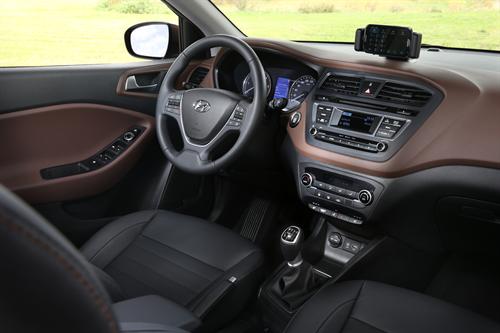
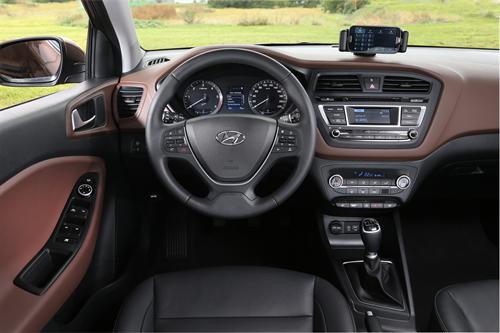
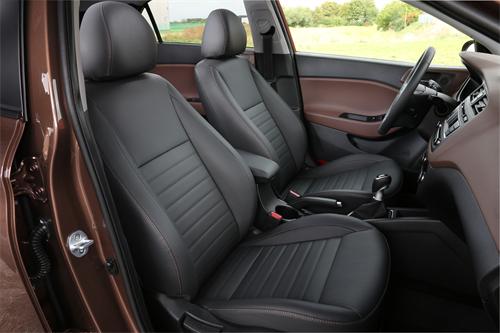
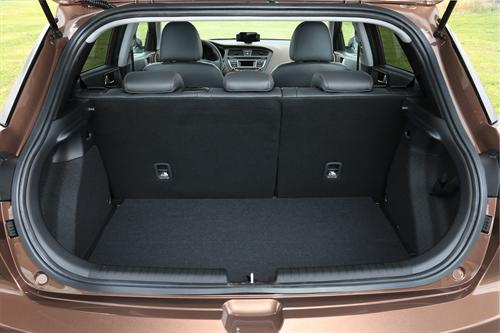 High Wycombe, 3 September – Hyundai Motor has released the first interior images of the New Generation i20, revealing the colourful, comfortable and high cabin that is a pleasure for driver and passengers to be in.
High Wycombe, 3 September – Hyundai Motor has released the first interior images of the New Generation i20, revealing the colourful, comfortable and high cabin that is a pleasure for driver and passengers to be in.
One of the highlights of the new interior is the use of contemporary colour blocks which heighten feelings of calm and create a spacious environment. An important goal for the design team was to ensure the New Generation i20’s perceived interior quality was among the best in the segment, benefiting from premium soft-touch material on all key surfaces. Independent customer reports in Germany and the UK ranked the car’s interior design and comfort higher than those of core competitors.
On many of the cabin’s surfaces a high-grade Thermal Plastic Olefin (TPO) material has been applied. The soft-touch material, found on the vehicle’s dashboard and door trims, is highly durable, maintaining a premium look and feel even after frequent use. The refined stitching on the seats was developed and executed to the highest standards to be both hard-wearing and stylish, in keeping with the rest of the interior design.
The interior colour schemes complement the exterior paint finishes and can easily be seen from the outside. The New Generation i20 interior is available in four vibrant hues: Elegant Beige, Grey Blue, Cappuccino and Comfort Grey. Each interior colour took inspiration from current interior design and lifestyle trends, giving each its own, distinctive character. The beige interior draws inspiration from the elegant Mediterranean way of living, while the vibrant blue and grey interior designs are influenced by the flagship stores of contemporary lifestyle brands. The rich brown shade echoes the lounge feeling of modern interior design.
To emphasise the impressive width and space – front-row occupants benefit from more head, leg and shoulder room, while the second row can comfortably seat three adults – a coloured inlay runs the full width of the dashboard and around the door handles. Matching the colour of the seat and door armrest upholstery, the inlay encompasses the newly designed air vents, which overhang the dashboard into the door – specifically designed to provide better airflow in and around the cabin.
In order to create a clean and efficient cabin, Hyundai’s ergonomics team grouped together key technologies such as audio, heating and ventilation to make the centre console as functional and easy-to-use as possible.
New Generation i20 will make its public world premiere at the 2014 Paris Motor Show. Hyundai’s press conference will take place in Hall 3 at 16:00 CET on Thursday 2 October.
